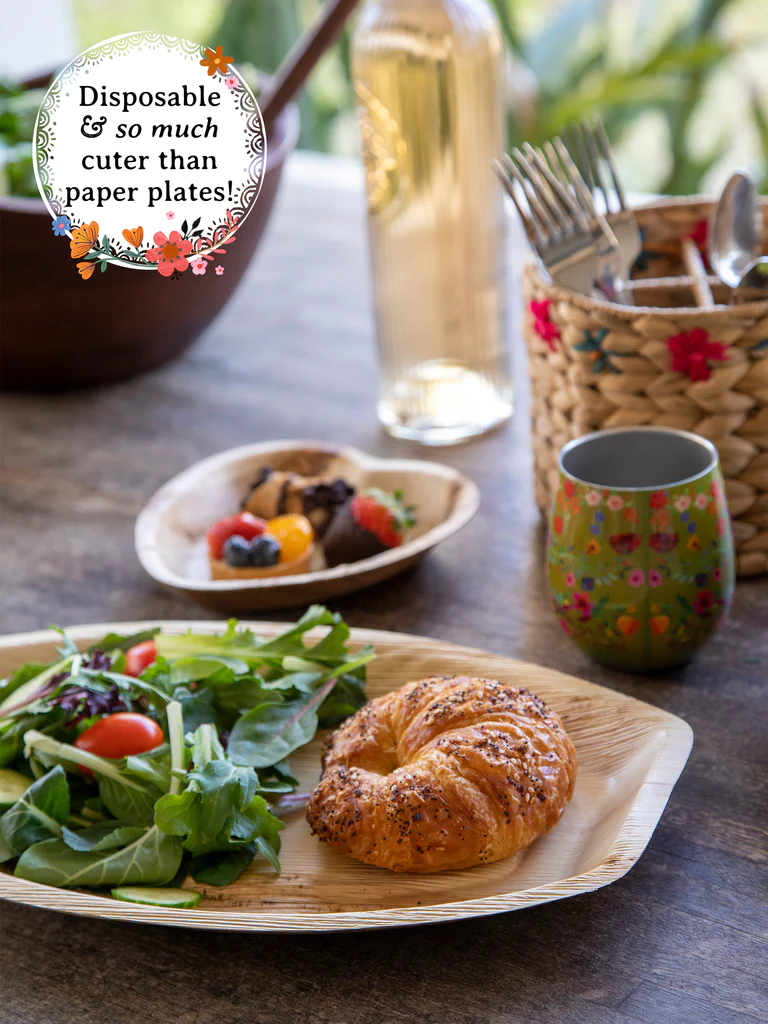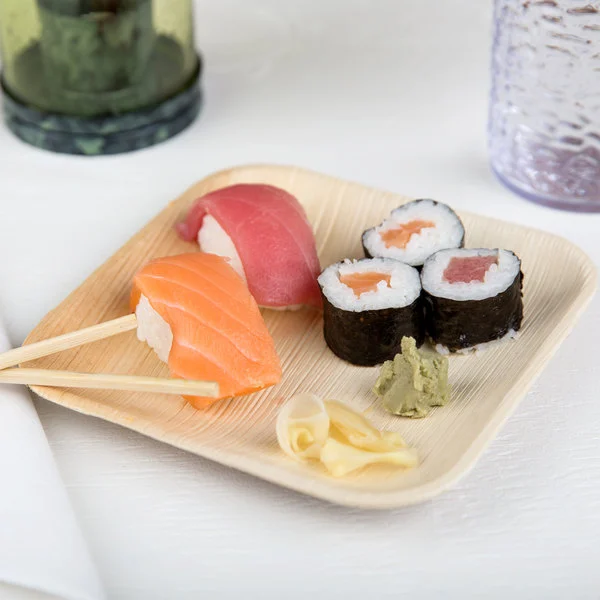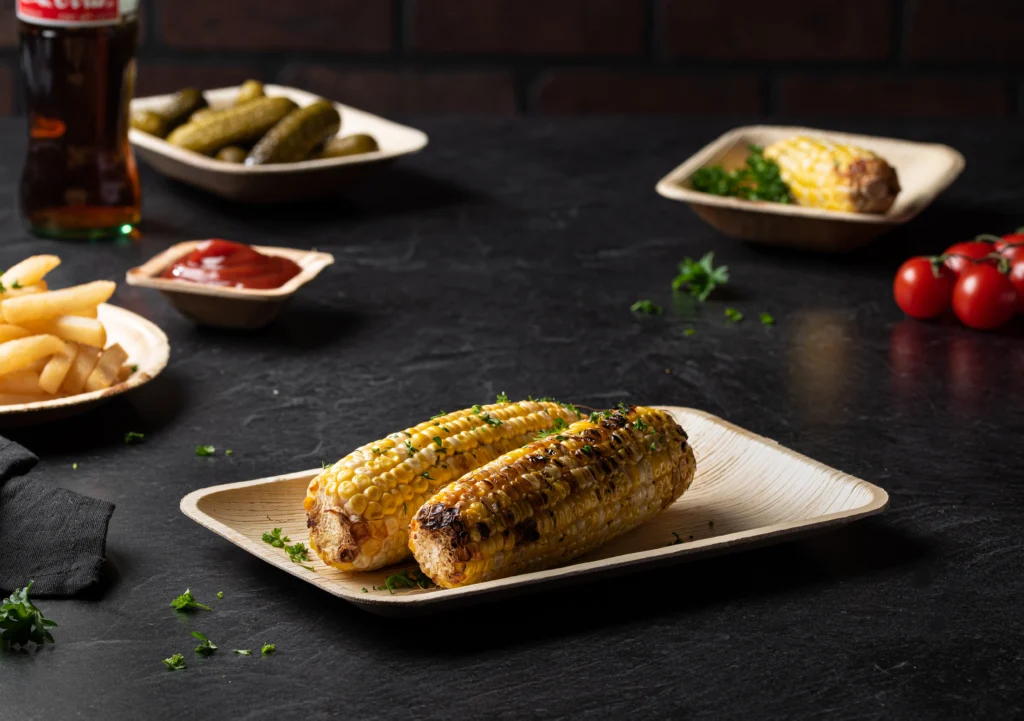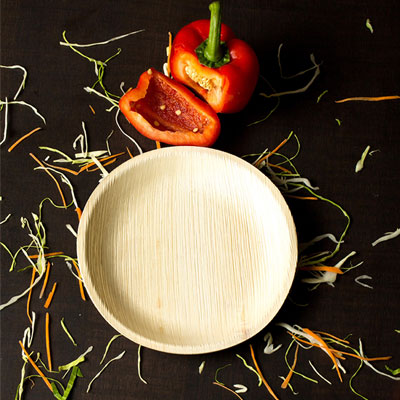Discover why Palm Leaf Plates are the future of event dining with their eco-friendly, stylish, and durable design, perfect for sustainable celebrations.
Introduction
In an era where sustainability has become more than just a buzzword, the event dining industry is witnessing a significant transformation. Biodegradable beauty, particularly through the use of palm leaf plates, is at the forefront of this change, marrying aesthetics with environmental consciousness. This article explores why palm leaf plates are not just a trend but a necessary step towards a more sustainable future in event dining.
Table of Contents
The Problem with Plastic
Non-Biodegradable Nature: The core issue with plastic is its non-biodegradable nature. Most plastics take hundreds to thousands of years to break down, and when they do, they fracture into microplastics. These tiny particles persist in ecosystems, infiltrating waterways, oceans, and wildlife, causing harm to organisms that ingest them.
Production and Pollution: The production of plastic is resource-intensive, relying heavily on fossil fuels. The process emits a considerable amount of greenhouse gases, contributing to global warming. Furthermore, the disposal of plastic, often through incineration, releases toxic pollutants into the air, exacerbating air quality issues and posing health risks to nearby communities.
Waste Management Challenges: Despite recycling efforts, a significant portion of plastic waste ends up in landfills or, worse, the natural environment. The durability of plastic, initially a selling point, becomes a detriment as it accumulates, leading to pollution and harming wildlife that mistake it for food.
Impact on Marine Life: The oceans bear the brunt of plastic pollution. Marine animals get entangled in discarded plastic items, and many species ingest plastic, mistaking it for food. This ingestion can lead to internal injuries, starvation, and death. The presence of plastics in the ocean also disrupts marine ecosystems and contributes to the decline of biodiversity.
Human Health Concerns: The consequences of plastic pollution extend to human health. Chemicals used in the manufacture of plastics, such as bisphenol A (BPA) and phthalates, can leach into food and beverages. These chemicals are endocrine disruptors and have been linked to a range of health issues, including reproductive problems and increased cancer risk.
Social and Economic Costs: The environmental impact of plastic translates into social and economic costs. Cleaning up plastic pollution requires significant financial resources, and the degradation of natural environments can impact industries such as tourism and fishing, which rely on clean, healthy ecosystems.

Palm Leaf Plates: An Overview
Natural and Sustainable: The process of making palm leaf plates involves collecting fallen leaves, which are then cleaned, soaked, and heat-pressed into various shapes and sizes—no trees are cut down to produce them. This method not only utilizes a renewable resource but also ensures that the plates are completely biodegradable and compostable, breaking down naturally without harming the environment.
Unique Aesthetic Appeal: One of the most striking features of palm leaf plates is their unique, natural look. Each plate has its own distinctive pattern, texture, and color, reflecting the leaf from which it was made. This adds an element of rustic elegance and authenticity to event dining, setting it apart from the uniformity of plastic or paper alternatives.
Durability and Versatility: Despite their natural composition, palm leaf plates are remarkably sturdy and versatile. They can accommodate a wide range of foods, including hot, cold, wet, or oily dishes, without bending, breaking, or absorbing moisture. This makes them an ideal choice for a variety of events, from casual outdoor picnics to elegant wedding receptions.
Eco-Friendly Production: The production of palm leaf plates is energy-efficient and low-impact, involving no chemicals, bleaches, or synthetic additives. This process not only minimizes environmental harm but also supports a sustainable industry that can contribute positively to local economies in palm-growing regions.
Compliance with Sustainability Goals: For event planners and attendees increasingly concerned with sustainability, palm leaf plates align perfectly with goals of reducing carbon footprints and minimizing waste. Their use sends a powerful message about prioritizing eco-friendly practices and can enhance the reputation of events and businesses that choose them.
The Future of Event Dining: As awareness of environmental issues grows, the demand for sustainable alternatives to traditional disposables is rising. Palm leaf plates are at the forefront of this change, offering a practical, beautiful, and eco-conscious choice that does not sacrifice convenience or style for sustainability. They exemplify how innovation and tradition can come together to provide solutions that benefit both people and the planet, making them a symbol of the future of event dining.
Benefits of Palm Leaf Plates
1. Environmental Sustainability: The most significant advantage of palm leaf plates is their eco-friendly nature. Being 100% biodegradable and compostable, they decompose naturally within a few months, leaving no toxic residues. This starkly contrasts with plastic disposables, which can take hundreds of years to break down, polluting the environment in the process.
2. Durability and Practicality: Despite their organic material, palm leaf plates are remarkably sturdy and can handle a variety of foods, including hot, cold, wet, or oily dishes, without bending, leaking, or becoming soggy. This makes them a practical option for event dining, where the reliability of tableware is crucial.
3. Aesthetic Appeal: Each palm leaf plate has a unique pattern, texture, and color, adding a touch of rustic charm and sophistication to the dining experience. Their natural, earthy look can complement any decor, from casual outdoor barbecues to elegant wedding receptions, enhancing the overall presentation of the meal.
4. Chemical-Free Production: The manufacturing process of palm leaf plates is straightforward and does not involve the use of chemicals, bleaches, or synthetic additives. This not only makes them safer for the environment but also ensures that they are free from potentially harmful substances, offering a healthier choice for consumers.
5. Energy-Efficient Manufacturing: The production of palm leaf plates is relatively low-energy, primarily involving the collection, cleaning, and heat-pressing of fallen leaves. This energy-efficient process contributes to a smaller carbon footprint compared to the manufacturing of plastic or paper disposables.
6. Supports Sustainable Livelihoods: The palm leaf plate industry provides sustainable livelihoods for communities in palm-growing regions. By utilizing a renewable resource that would otherwise go to waste, this industry promotes economic development without harming the environment.
7. Versatility in Use: Palm leaf plates are suitable for a wide range of events, from formal dinners to casual picnics. Their natural insulation properties also make them ideal for serving both hot and cold dishes, further showcasing their versatility.
8. Complements Eco-Conscious Brands: For businesses and event planners looking to demonstrate a commitment to sustainability, palm leaf plates offer a tangible way to align operations with eco-friendly values. Their use can enhance a brand’s image and appeal to environmentally conscious consumers.

How Palm Leaf Plates are Made
The production of palm leaf plates is a fascinating process that marries traditional methods with eco-friendly practices, resulting in a product that is both sustainable and functional. This process utilizes the fallen leaves of the Areca palm tree, ensuring that no trees are harmed in the making of these plates. Here’s a step-by-step overview of how palm leaf plates are made:
1. Collection of Fallen Leaves: The first step involves gathering fallen Areca palm leaves, which are naturally shed by the trees. This sustainable practice ensures that the production process does not contribute to deforestation or harm the natural growth cycle of the trees.
2. Cleaning: Once collected, the leaves are thoroughly cleaned with water to remove any dirt and debris. This step is crucial to ensure that the final product is hygienic and suitable for use in dining.
3. Drying: After cleaning, the leaves are left to dry naturally under the sun. This not only reduces the energy footprint of the production process but also prepares the leaves for the next stage of manufacturing by removing excess moisture.
4. Sorting and Trimming: The dried leaves are then sorted based on quality, size, and shape. Any excess parts are trimmed off to ensure uniformity and to prepare them for pressing into plates.
5. Heat Pressing: The core of the manufacturing process involves heat pressing the leaves into desired shapes and sizes. The leaves are placed between two metal molds of the specific plate design and then heat-pressed. The heat and pressure cause the leaves to mold into the plate shape, while also sterilizing them. This process is completely natural and does not involve any chemicals or additives.
6. Trimming and Finishing: After pressing, the edges of the plates may be trimmed for a neat finish, and any final touches are applied. This step ensures that each plate meets quality standards and is ready for use.
7. Packaging: Finally, the plates are packaged for sale. The packaging is often made from sustainable materials as well, keeping in line with the eco-friendly ethos of the product.
Palm Leaf Plates in Event Dining
Eco-Friendly Elegance: Event planners and hosts are constantly seeking ways to differentiate their events and make them memorable. Palm leaf plates, with their natural, rustic aesthetic, add a touch of elegance and authenticity that cannot be achieved with traditional disposable tableware. Their unique patterns and textures make each plate a conversation starter, elevating the overall dining experience.
Versatility for Any Event: Whether it’s a casual outdoor barbecue, a sophisticated wedding reception, or a corporate gala, palm leaf plates fit seamlessly into any setting. Their durability makes them suitable for serving a wide variety of foods, from hot entrees to cold desserts, without the risk of leakage or collapse that can accompany less sturdy disposables.
Sustainability as a Selling Point: With a growing emphasis on environmental responsibility, the use of palm leaf plates at events sends a strong message about commitment to sustainability. This can enhance the reputation of businesses and event planners who choose them, appealing to guests who value eco-friendly practices. Incorporating palm leaf plates can also contribute to achieving green certifications or awards for sustainability in event management.
Case Studies of Success: Numerous events have successfully incorporated palm leaf plates, showcasing their practicality and appeal. For example, eco-themed weddings that prioritize sustainability in every aspect of their planning have found palm leaf plates to perfectly complement their ethos. Corporate events focused on sustainability have used them to underscore their commitment to eco-friendly practices. Feedback from these events often highlights not only the aesthetic appeal of the plates but also the positive reception from guests who appreciate the thoughtful choice.
Event Planner Perspectives: Professionals in the event planning industry have praised palm leaf plates for their ease of use and disposal, cost-effectiveness compared to traditional rentals, and the positive impact on their event’s environmental footprint. They also appreciate the wide range of sizes and shapes available, which allows for creative presentation and serving options.
Consumer Reception: Guests at events where palm leaf plates are used frequently express admiration for their unique look and feel, as well as appreciation for the environmentally friendly choice. This positive reception can enhance the overall experience of the event, leaving guests with a lasting impression of innovation and responsibility.
Challenges and Solutions: While the adoption of palm leaf plates is growing, some challenges, such as availability and initial cost comparisons with cheaper, less eco-friendly options, can arise. However, these challenges are increasingly being addressed through wider distribution channels and bulk purchasing options, making palm leaf plates more accessible and cost-effective for event planners.

Challenges and Solutions
Challenges
1. Availability and Accessibility: Palm leaf plates may not be as readily available as traditional disposable tableware in some regions, making it difficult for event planners to source them, especially for last-minute events.
Solutions:
- Bulk Purchasing: Planning ahead and buying palm leaf plates in bulk can ensure availability and also reduce costs.
- Online Suppliers: Exploring online marketplaces can provide access to a wide range of suppliers offering palm leaf plates, often with options for bulk purchases and delivery.
- Local Vendors: Establishing relationships with local vendors who specialize in eco-friendly products can improve access and encourage them to stock palm leaf plates.
2. Cost Comparison: Palm leaf plates can be more expensive than plastic or paper alternatives, which might deter budget-conscious event planners.
Solutions:
- Value Proposition: Emphasize the value addition in terms of aesthetic appeal and environmental impact, which can justify the higher cost.
- Economies of Scale: As demand increases and production processes improve, the costs are likely to decrease. Supporting eco-friendly products now can contribute to future affordability.
- Budget Allocation: Incorporating the cost of sustainable tableware into the event’s sustainability budget can help manage overall expenses.
3. Lack of Awareness: Some event planners and consumers may not be aware of palm leaf plates or their benefits, leading to continued reliance on less sustainable options.
Solutions:
- Education and Promotion: Information campaigns highlighting the environmental benefits and versatility of palm leaf plates can increase awareness.
- Showcasing Success Stories: Sharing case studies and testimonials from successful events that used palm leaf plates can inspire others to consider them.
4. Misconceptions About Durability and Usability: There may be misconceptions that biodegradable plates are less durable or not suitable for all types of food.
Solutions:
- Product Demos: Offering samples or demonstrations of palm leaf plates at industry events can dispel myths about their durability and usability.
- Educational Materials: Providing detailed information on the manufacturing process, use cases, and comparative advantages can help correct misconceptions.
Solutions for Broader Adoption
Engaging Stakeholders: Collaboration with event venues, caterers, and suppliers can encourage the adoption of palm leaf plates by making them a preferred option for eco-conscious events.
Incentives for Sustainability: Governments and industry associations could offer incentives, such as certifications, awards, or subsidies, to businesses that commit to sustainable practices, including the use of palm leaf plates.
Community Engagement: Engaging with the local community through workshops, school programs, and public events can raise awareness about sustainable dining options and drive demand for products like palm leaf plates.
Conclusion
Palm leaf plates represent a beautiful, practical, and sustainable choice for event dining, aligning with the growing demand for environmentally responsible products. Their adoption not only reduces the environmental impact of events but also enhances the dining experience with their unique aesthetic. As we move towards a more sustainable future, palm leaf plates stand out as a beacon of eco-friendly innovation in the event industry.
FAQs
- How long do palm leaf plates take to decompose?
- Can palm leaf plates handle all types of food?
- Are palm leaf plates more expensive than plastic?
- How are palm leaf plates made?
- What makes palm leaf plates a sustainable option for event dining?

Your blog is a testament to your dedication to your craft. Your commitment to excellence is evident in every aspect of your writing. Thank you for being such a positive influence in the online community.